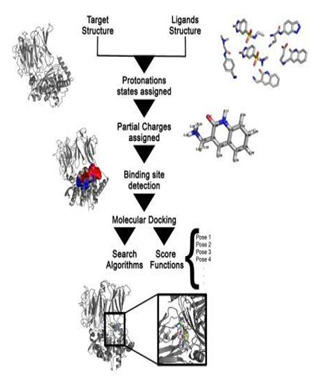Novel and Heuristic MolDoc Scoring Procedure for Identification of Staphylococcus Aureus
Keywords:
Staphylococcus aureus, mol doc scoring, drug target selection, drug target identification, protein-protein sequenceAbstract
Staphylococcus aureus has gotten an adaptable microorganism fit for causing a wide extent of human ailments generally in view of a striking assortment of danger useful properties which are grants it to persevere through ludicrous guidelines inside the host of the protein grouping. Staphylococcus aureus is a common human pathogen, and this paper offers a medication-focused metabolic route for staphylococcus aureus. Use a range of constraining measures, from -59.15 k/m to -193.616 k/m, to characterize protein-ligand analysis in docking. Define the optimal bounds for particle loads in the innovative MolDock Scoring method. Efficient protein-ligand interactions can be deduced from protein data through the use of an atom mooring scoring approach, as revealed by research. In a flash applied on various informational collections concerning handling disregarded atoms as the best inhibitor against phosphotransacetylase.
Downloads
References
Butt, A.M., Tahir, S., Nasrullah, I., Idrees, M., Lu, J. and Tong, Y. (2012) ‘Mycoplasma genitalium: a comparative genomics study of metabolic pathways for the identification of drug and vaccine targets’, Infection, Genetics and Evolution, Vol. 12, No. 1, pp.53–62.
Carleton, H.A., Diep, B.A., Charlebois, E.D., Sensabaugh, G.F. and Perdreau-Remington, F. (2004) ‘Community-adapted methicillin-resistant Staphylococcus aureus (MRSA): population dynamics of an expanding community reservoir of MRSA’, Journal of Infectious Diseases, Vol. 190, pp.1730–1738.
Dinges, M.M., Orwin, P.M. and Schlievert, P.M. (2000) ‘Exotoxins of Staphylococcus aureus’, Clin. Microbiol. Rev., Vol. 13, pp.16–34.
Dutta, A., Singh, S.K., Ghosh, P., Mukherjee, R., Mitter, S. and Bandyopadhyay, D. (2006) ‘In silico identification of potential therapeutic targets in the human pathogen helicobacter pylori’, In Silico Biology, Vol. 6, Nos. 1–2, pp.43–47.
Foster, T.J. (2005) ‘Immune evasion by staphylococci’, Nat Rev Microbiol, Vol. 3, No. 12, pp.948–958.
George, Y.L. (2009) ‘Molecular pathogenesis of Staphylococcus aureus infection’, Pediatr Res, Vol. 65, No. 5, Pt 2, pp.71R–77R.
Gordon, R.J. and Lowy, F.D. (2008) ‘Pathogenesis of methicillin-resistant Staphylococcus aureus Infection’, Clin. Infect. Dis., Vol. 46, Supplement 5, pp.S350–S359.
Haag, N.L., Velk, K.K. and Wu, C. (2011) ‘In silico identification of drug targets in methicillin/multidrug-resistant Staphylococcus aureus’, BIOTECHNO: The Third International Conference on Bioinformatics, Biocomputational Systems and Biotechnologies, Venice/Mestre, Italy, pp.91–99.
Jalaie, M. and Shanmugasundaram, V. (2006) ‘Virtual screening: are we there yet?’, Mini Rev. Med. Chem., Vol. 6, p.1159.
Kubica, M., Guzik, K., Koziel, J., Zarebski, M., Richter, W., Gajkowska, B., Golda, A., Maciag-Gudowska, A., Brix, K., Shaw, L., Foster, T. and Potempa, J.A. (2008) ‘Potential new pathway for Staphylococcus aureus dissemination: the silent survival of S. aureus phagocytosed by human monocyte-derived macrophages’, PLoS One, Vol. 3, p.e1409.
Lipinski, C.A., Lombardo, F., Dominy, B.W. and Feeney, P.J. (1997) ‘Experimental and computational approaches to estimate solubility and permeability in drug discovery and development settings’, Adv. Drug Deliv. Rev, Vol. 23, pp.3–25.
Lowy, F.D. (1998) ‘Staphylococcus aureusinfections’, The New England Journal of Medicine, Vol. 339, pp.520–532.
Lyne, P.D. (2002) ‘Structure-based virtual screening: an overview’, Drug Discov. Today, Vol. 7, p.1047.
Malabendu, J., Luong, T., Komatsuzawa, H., Shigeta, M. and Lee, C.Y. (2000) ‘A method for demonstrating gene essentiality in Staphylococcus aureus’, Plasmid, Vol. 44, pp.100–104.
Maresso, A.W. and Schneewind, O. (2006) ‘Iron acquisition and transport in Staphylococcus aureus’, Biometals, Vol. 19, pp.193–203.
Morya, V.K., Dewaker, V., Mecarty, S.D. and Singh, R. (2010) ‘In silico analysis metabolic pathways for identification of putative drug targets for Staphylococcus aureus’, Journal of Computer Science & Systems Biology, Vol. 3, No. 3, pp.062–069.
Morya, V.K., Kumari, S. and Kim, E.K. (2012) ‘Virtual screening and evaluation of ketol-acid reductoisomerase (KARI) as a putative drug target for aspergillosis’, Clinical Proteomics, Vol. 9, No. 1, p.1.
Sarkar, M., Maganti, L., Ghoshal, N. and Dutta, C. (2012) ‘In silico quest for putative drug targets in Helicobacter pylori HPAG1: molecular modeling of candidate enzymes from lipopolysaccharide biosynthesis pathway’, Journal of Molecular Modelling, Vol. 18, No. 5, pp.1855–1866.
Von Eiff, C., Peters, G. and Becker, K. (2006) ‘The small colony variant (SCV) concept – the role of staphylococcal SCVs in persistent infections’, Injury, Vol. 37, pp.26–33.
Xu, Q.S., Jancarik, J., Lou, Y., Kuznetsova, K., Yakunin, A.F., Yokota, H., Adams, P., Kim, R. and Kim, S.H. (2005) ‘Crystal structures of a phosphotransacetylase from Bacillus subtilis and its complex with acetyl phosphate’, Journal of Structural and Functional Genomics, Vol. 6, No. 4, pp.269–279.
Yadav, P.K., Singh, G., Singh, S., Gautam, B. and Esmaiel IF Saad (2012) ‘Potential therapeutic drug target identification in community acquired-methicillin resistant Staphylococcus aureus (CA-MRSA) using computational analysis’, Bioinformation, Vol. 8, No. 14, pp.664–672.

Downloads
Published
How to Cite
Issue
Section
License

This work is licensed under a Creative Commons Attribution-ShareAlike 4.0 International License.
All papers should be submitted electronically. All submitted manuscripts must be original work that is not under submission at another journal or under consideration for publication in another form, such as a monograph or chapter of a book. Authors of submitted papers are obligated not to submit their paper for publication elsewhere until an editorial decision is rendered on their submission. Further, authors of accepted papers are prohibited from publishing the results in other publications that appear before the paper is published in the Journal unless they receive approval for doing so from the Editor-In-Chief.
IJISAE open access articles are licensed under a Creative Commons Attribution-ShareAlike 4.0 International License. This license lets the audience to give appropriate credit, provide a link to the license, and indicate if changes were made and if they remix, transform, or build upon the material, they must distribute contributions under the same license as the original.





